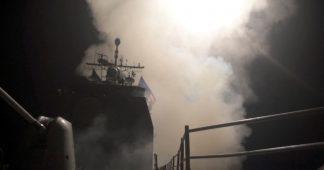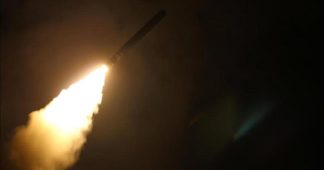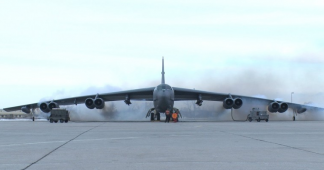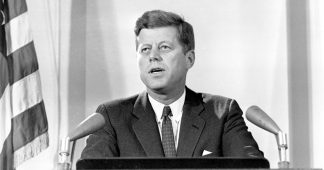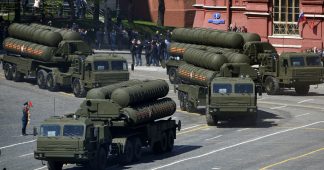Edited by William Burr
Aug 15, 2018
Pre-delegation Instructions Excluded Yugoslavia from Attack on “Sino-Soviet” Nations
SIOP-64 Established Overkill Levels of Expected Damage: 95 Percent
The SIOP Revisited
U.S. nuclear war plans during the Johnson administration included the option of a retaliatory strike against nuclear, conventional military, and urban-industrial targets with the purpose of removing the Soviet Union “from the category of a major industrial power” and destroying it as a “viable” society. This is one disclosure from a Joint Staff review of the Single Integrated Operational Plan (SIOP) obtained via a Mandatory Declassification Review request by the George Washington University-based National Security Archive and posted on our site today.
The document, the Joint Staff’s review of SIOP guidance in June 1964, showed continued acceptance by policymakers of the cataclysmic nuclear strike options that had been integral to the plan since its inception. Accordingly, the SIOP set high damage requirements—95 percent for the top priority nuclear targets—ensuring that it remained an “overkill” plan, referring to its massively destructive effects. Prepared and continually updated by the Joint Strategic Target Planning Staff, the SIOP has been characterized by some as a “doomsday machine.”[1]
U.S. nuclear war planning drew on Cold War assumptions about the danger of a Soviet surprise attack against the United States.[2] The possibility that deterrence could fail and that U.S.-Soviet conflict could break out made U.S. defense officials seek attack options “capable of execution under all reasonably foreseeable conditions under which hostilities may begin.”[3] For such purposes, the SIOP included a retaliatory option in the event of a Soviet surprise attack and a preemptive option in the case of intelligence warning of an imminent Soviet attack
The U.S. government has never declassified any version of the SIOP, forcing researchers to rely on ancillary documentation to shed useful light on elements of the plan. The Joint Staff review posted today is the latest such evidence. Base-line declassified knowledge about earlier versions of the SIOP includes:
- SIOP-62 and its successors involved massive nuclear strikes against Sino-Soviet targets, with thousands of weapons aimed at over a thousand targets, with “Alpha” category nuclear weapons and delivery systems – nuclear-tipped missiles and bombers loaded with nuclear weapons – the top priority.
- To satisfy policymakers who wanted the president to have a wider range of choices, by late 1962 the SIOP included two preemptive and three retaliatory options. Included in the Football briefing material for the President, the SIOP options were strikes, sometimes in combination, on nuclear weapons and delivery systems (Task Alpha), on non-nuclear military targets (Task Bravo), and on urban-industrial targets (Task Charlie).
- SIOP-63 established a high damage expectancy of 90 percent probability of severe damage to targets, a requirement that made the SIOP an instrument of “overkill” because multiple nuclear weapons would strike high priority targets
The Joint Staff review of the SIOP-64 guidance includes new information on nuclear war planning:
- The SIOP guidance permitted “withholds” to hold back strikes on specific countries. Recognizing the reality of Sino-Soviet tensions, it would be possible to launch nuclear strikes against the Soviet Union without attacking China or vice versa or to withhold strikes from Eastern European countries, namely Albania, Bulgaria, and Romania
- Priorities for Task Alpha targets: At the top of the list of the most urgent target categories were: heavy and medium bomber bases, unprotected ICBM sites (silos did not shield Soviet ICBMs until early 1964), and IRBM/MRBM [intermediate range/medium range ballistic missile] sites.
- For the top priority “Task Alpha” targets, the SIOP-64 guidance set an even higher damage expectancy of 95 percent, “a high degree of probability of damage.” Thus, overkill continued to be baked into the SIOP. Yet, because nuclear planners based their assessments of damage on the blast effects of nuclear explosions, they did not take into account the further devastation caused by fire effects, especially in urban areas.[4]
- The purpose of one of the retaliatory options was to destroy the Soviet Union as a “viable” society because it targeted Soviet military forces (conventional and nuclear) plus strikes on urban-industrial targets – Task Charlie.
Unlike the 1956 Strategic Air Command Report on target systems in 1959, the SIOP guidance paper was written at a fairly high level of generality that did not include discussion of specific target systems. Nor did it review specific nuclear weapons delivery vehicles, making references only to “survivable” delivery forces for urban-industrial targets and “rapid reaction offensive forces” for the urgent Task Alpha targets. Plainly these were references to the survivable Polaris SLBMs and the rapid response Minutemen and Titan ICBMs. By May 1964, not long before Taylor circulated the guidance paper, the Pentagon had hundreds of missiles for SIOP tasks: 488 alert Minutemen, 70 Titan I and II; and 208 Polaris A-1 and A-2 SLBMs. Besides the missiles, the arsenal of nuclear delivery vehicles included 630 B-52 and 450 B-47 bombers, the latter of which were being phased out. [5]
Preemption
The SIOP’s preemptive options should not be confused with a first strike. President Eisenhower had ruled out one first-strike possibility, preventive war against the Soviet Union, but the option for a preemptive strike against Soviet military targets became standard in U.S. nuclear planning. Informing preemption was the prospect that strategic intelligence could produce warning of an impending Soviet attack that a U.S. strike could avert or at least blunt. Moreover, some military planners believed that by destroying Soviet nuclear forces first a preemptive strike could limit damage to the United States. Yet, by September 1963, top defense officials were concluding that damage limitation strategies could fail. At a White House briefing on the 1963 report of the highly secret Net Evaluation Subcommittee [NESC], General Leon Johnson told the president that “There is no way, no matter what we do, to avoid unacceptable damage in the U.S. if nuclear war breaks out.”[6] All the same, preemption remained in the menu of SIOP options and the logic of damage limitation “became deeply ingrained in decisions about the numbers and capabilities of the U.S. nuclear arsenal.”[7]
Vice President Johnson did not attend the meeting on the NESC report and it is unknown whether Secretary of Defense Robert McNamara briefed him on the limits of preemption. McNamara, however, was confident that should nuclear war come he and the president could have improvised an attack without relying on the SIOP options.[8]
The urgency given to counterforce targets and the availability of preemptive options added momentum and instability to the U.S.-Soviet strategic competition. Washington identified more Soviet nuclear installations for the target lists, which then boosted the Pentagon’s requirements for more nuclear warheads. Putting ICBMs on high alert for counterforce missions added to the risk of accidental nuclear war as did the preemptive option. The primacy the Joint Staff gave to the counterforce mission guaranteed that the SIOP would be an instrument of overkill but may have been inconsistent with stable deterrence.[9]
U.S. apprehensions notwithstanding, a first strike was never part of Soviet military doctrine. Yet Soviet political and military leaders feared a U.S. first strike, mirror imaging Washington’s fears. While some Soviet military officials sought a preemptive capability, key leaders such as Deputy Premier Alexei Kosygin rejected it altogether.[10]
Pre-delegation
Also published today by the National Security Archive is new information on the nuclear pre-delegation instructions approved by President Johnson in March 1964, codenamed “Furtherance.” The instructions covered a specific contingency: if the Soviet Union launched a surprise attack and if the U.S. president and successors could not be reached, and if detonation of nuclear weapons on U.S. territory could be confirmed. Under those circumstances,
U.S. commanders could respond with an all-out attack against the “Sino-Soviet” bloc, which meant all countries allied with Moscow and Beijing. According to a recently declassified document from the Lyndon B. Johnson Library, published today by the National Security Archive, only Yugoslavia, an estranged Soviet ally, would be spared from the nuclear strike, because of its independent status.
Document 01
Memorandum by C.V. Clifton, “List of Things Which Have to be Done as a Result of the Joint Chiefs of Staff Meeting with the President on March 4, 1964,” 23 March 1964, Top Secret
Document 02
Joint Chiefs of Staff Chairman Maxwell Taylor to Generals LeMay, Wheeler, and Greene, and Admiral McDonald, “Review of the SlOP Guidance,” 5 June 1964, CM [Chairman’s Memorandum] -1407-64, Top Secret
Priorities and Operations
Target withholds were only one issue in the Joint Staff review of SIOP guidance that had been requested at an October 1963 meeting of top Defense and JCS officials at Strategic Air Command headquarters, of which no record is yet available. The guidance review took into account the highly secret Joint Strategic Capabilities Plan that assigned wartime missions, such as target priorities, to the Strategic Air Command among other commands.[12] For example, JSCP-65 stipulated that the “military objective in general war …[was] to defeat the Soviet Bloc alone or in combination with the Asian communist Bloc.” Consistent with that objective, U.S. nuclear forces were to “destroy or neutralize on a selective basis if required, the military capabilities of the enemy, as necessary to limit damage to the United States and its allies to the maximum extent practicable.” Moreover, strategic forces were to “maintain an assured capability under all conditions [to] destroy, on a selective basis, the war supporting and urban/industrial resources of the enemy.”
The guidance review reaffirmed the five attack options that had been designed for SIOP-63. Two were preemptive attack options – I: strikes against nuclear targets, II: strikes against nuclear and non-nuclear military targets); and three were retaliatory attack options – III: nuclear targets, IV: nuclear and non-nuclear military, and V: military and urban industrial. As before, the top priority was “destroying or neutralizing the enemy’s military capabilities,” with precedence given to nuclear threat targets (Alpha category). The “secondary concern” was extending the attack to urban-industrial targets. According to Maxwell Taylor’s cover memorandum, this order of priorities was something that he believed needed further review.
The Joint Staff endorsed the practice of keeping attacks on urban-industrial targets (Charlie category) as part of a separate option because, if all attack options combined military and urban-industrial targets, that would deny the U.S. government “any selectivity in our attack and could dictate automatically the destruction of US urban industrial areas by the enemy.” Attack Option V, a retaliatory option, was the only one that targeted a combination of nuclear, non-nuclear military, and urban industrial targets in such a way as to “destroy the will and ability of the Sino-Soviet Bloc to wage war, remove the enemy from the category of a major industrial power, and assure a post-war balance of power favorable to the United States.”
Apparently, there was some hope in the Joint Staff that striking nuclear threat targets only could signal an intent to spare urban areas that could be reciprocated. Yet, the attacks on military targets would have been so massive as to undermine any notion of “selectivity.” The guidance review did not discuss numbers of weapons assigned to the strike options and no such information from the mid-1960s is available, but in 1969 the Alpha preemptive strike, the “smallest” SIOP option, targeted about 1,750 nuclear weapons on Soviet nuclear forces and delivery systems.
Population as an Objective
The emphasis on a capability to destroy urban-industrial targets provided context for a related issue in the SIOP review: the Joint Staff raised the possibility of using “population loss as the primary yardstick for effectiveness in destroying the enemy society with only collateral attention to industrial damage.” The implication of this alarming statement was that as long as urban workers, clerks, and managers were killed the level of damage to industrial targets might not be as important. Given the JSCP-65 requirement for “an assured capability to destroy the enemy’s war supporting and urban/industrial resources,” fatalities were likely to increase “in that a larger portion of the urban population may be placed at risk.” Placing “at risk” amounted to using population loss as a “primary yardstick” but whether that criterion became embedded in SIOP planning remains to be learned.
According to the Joint Staff review, a recent study, done in conjunction with the Joint Strategic Target Planning Staff, considered what needed to be done “to destroy the USSR and China as viable societies.” In the SIOP-64 guidance, the targeting objectives already in place, including the destruction of 70 percent of industrial floor space, could achieve “the destruction of the USSR as a viable society.” Meeting that goal for China was more complicated because so much of the population was agrarian. A requirement for 30 percent fatalities of the total Chinese population, amounting to 212 million people, “would necessitate an exorbitant weight of effort”; because 84 percent of the population was in rural areas, “the attack of a large number of place names would destroy only a small fraction of the total population of China.” Moreover, once the top 30 cities were destroyed, according to the Joint Staff, “the rate of return for a weapon expended diminishes rapidly.” To correct this problem, the Joint Staff would be looking at “alternative examples of redistribution of targeting weights of effort between the various categories of targets and to derive theoretical consequences of execution of a SlOP thus retargeted.”
Later in the guidance paper, the Joint Staff further discussed what it could take to destroy China as a “viable” society. To achieve that, the Joint Staff suggested cutting back on the goal of destroying 50 cities and 70 percent of industrial floor space as specified in the SIOP-64 guidance. Instead, keeping in mind the mainly agrarian character of Chinese society, the Joint Staff relaxed the criteria for Attack Option V, the retaliatory attack combining military and urban-industrial targets. It would aim at destroying 30 cities with the goal of 30 percent urban fatalities and destroying 50 percent of industrial floor space.
Implementing Option V in that way “would destroy such a level of the Chinese urban population and industrial capacity that China would no longer be a viable nation.”
The fingerprints of Secretary of Defense Robert McNamara can be found in some of the language in the Joint Staff guidance review. McNamara made the concept of “assured destruction” basic to the way that top Pentagon officials sized U.S. strategic forces.[13] It meant a retaliatory strike that could destroy the Soviet government and command centers along with “a large percentage of their population and economy” (e.g. 30 percent of population, 50 percent of industrial capacity, and 150 cities). The type of precision associated with McNamara’s thinking can be seen in the Joint Staff SIOP guidance review, for example, in the discussion of how China could be destroyed as a “viable” society.
The SIOP guidance review did not include any specific discussion of casualty levels. No casualty estimates from 1964 are available but other declassified documents provide a sense of the terrible scale. According to a 1961 estimate, a full force SIOP attack could cause a 71 percent casualty rate in Soviet cities and 53 percent in Chinese cities. An estimate from the following year projected 70 million Soviet fatalities caused by a no-warning U.S. strike on combined military and urban-industrial targets. By contrast the Defense Department estimated that a U.S. strike on military targets only via “ground-burst” would cause 55 million Soviet fatalities.
Target Priorities and Allocation of Delivery Systems
That “Task Alpha” targets (nuclear forces) were “time sensitive” suggested that they would be struck, according to the Joint Staff, by “rapid reaction forces”—implicitly Minuteman missiles. By contrast, “highly survivable” systems, implicitly Polaris submarine-launched ballistic missiles, would be assigned to urban-industrial “Charlie” targets because “an assured capability must be provided under all conditions to destroy” them. To ensure that a survivable capability was available, the guidance for SIOP-64 directed the “establishment of a secure retaliatory force” for this purpose.
For destroying the most time-sensitive Task Alpha targets, SIOP-64 established the following priorities, which was generally, but not completely, consistent with top precedent targets in SIOP-63:
(1) Active heavy and medium bomber home bases and primary staging bases.
(2) Soft ICBM sites.
(3) Known and fixed IRBM/MRBM sites.
(4) Primary missile launching submarine bases (or their access to the sea).
(5) Primary heavy and medium bomber dispersal bases and active light bomber home bases.
(6) Primary nuclear and CBR [Chemical/Biological/Radiological] weapons storage facilities outside of major urban centers.
(7) Known active local control centers that exercise control over nuclear delivery forces which present a threat to the United States or its Allies, not co-located with those forces, but located outside of major urban centers.
That the destruction of bomber bases had even greater urgency than “soft” ICBM sites is an interesting problem which may possibly be explained by the large numbers of Soviet bombers that threatened not only the U.S. but also NATO allies and U.S. bases and troops. That “local control centers” for nuclear delivery systems were to be excluded from the priority list if they were located in “major urban centers” was significant because it indicated some degree of effort, consistent with the McNamara “no cities” approach, to protect urban populations from a counter-force strike.[14]
With the U.S.’s growing deployments of ICBMs, the Joint Staff proposed one change in priorities. Item seven, the nuclear control centers, should get a higher ranking, below three and above four, because they were a time-sensitive target category. In other words, the control centers needed to be struck earlier to disrupt the Soviet attack, but as in SIOP-63, to minimize civilian losses they would be the ones located outside of urban areas.
Damage Expectancy
As in earlier SIOPs, the guidance for SIOP-64 stipulated high expectancy [DE], 90 percent, of severe damage to targeted installations. That would be the goal for all targets except the “hard targets” in the Alpha category. Implicitly 90 percent was the goal for urban-industrial and non-nuclear military targets. 90 percent was neither “a maximum nor a minimum, but one which is highly desirable and probably attainable with the available forces.”[15]
Because of the top priority given to destroying nuclear threat targets, the guidance assigned a 95 percent expectancy of damage. Considering the uncertainties associated with launching and landing a weapon on target, the guidance for SIOP-64 stipulated that the “over-all damage expectancy to any single DGZ [designated ground zeroes] should not exceed 95% except for those targets of highest priority.” As meeting a high DE could require the assignment of multiple bombs and warheads, the Joint Staff allowed that high numbers “may not be consistent with economical weight of effort.” To balance those considerations, the Joint Staff recommended revising the guidance “to provide more specific instructions.”
Why the authors of the SIOP-64 guidance considered 95 percent to be possible and necessary remains obscure. With more Minuteman I’s becoming available, perhaps significant numbers were to be targeted on the hundreds of Soviet ICBM and MRBM sites. The more accurate Minuteman II would not become available until late 1965; it would have a circular error probable (CEP) in the 0.26-0.34 nautical miles range compared to 1.1. nm for Minuteman I; a significant difference that made it a “counterforce weapon.”[16]
So that forces implementing Task Charlie achieved the “prescribed” damage expectancy of 90 percent, the Joint Staff recommended that allocations of forces assigned to the urban-industrial task be given “equal priority with the objectives of Task Alpha.” Those force allocations would especially apply to retaliatory strike Option V (combining Alpha, Bravo, and Charlie objectives) if a Soviet surprise attack occurred when U.S. forces were in a “normal alert posture.” Whether force allocations were so restructured is unclear, but as of 1969, 11 percent of strategic forces were committed to the Charlie objective, but whether that was more or less than in 1964 is presently unknown.
Major recommendations on SIOP guidance would have reached Secretary of Defense Robert McNamara but no paper trail is presently available on that point. While McNamara saw an assured destruction force as adequate for deterrence, the SIOP did not include such an option because of its heavy emphasis on counter-force. Indeed, assured destruction was antithetical to the SIOP because it assumed just enough forces for retaliation against a smaller target set. Years later, McNamara told author Deborah Shapley that had the circumstances arisen, he and the president could have improvised: “we had complete presidential control over [the SIOP]” and “we knew how, on a rough basis, to cut back on the strike options.” Yet, he conceded that he “never did modify the SIOP to reflect realistic alternatives.”[17]
Later in the 1960s, a new president, Richard M. Nixon, was aghast when he learned about the scale of the SIOP attack options and concluded that a president needed military options that did not result in Armageddon. Hoping that more choices could prevent escalation and make nuclear weapons more usable diplomatically, the Nixon administration initiated a search for limited nuclear options, which would become elements of the SIOP during the last years of the Cold War.
Note: Thanks to Lynn Eden, Senior Research Scholar Emerita, Stanford University, for incisive comments on a draft of this posting.
Notes
[1] . See “David Alan Rosenberg on: U.S. Planning for a Soviet Nuclear Attack,” Interview Transcript, PBS. “Race for the Superbomb,” and Daniel Ellsberg, The Doomsday Machine: Confessions of a Nuclear War Planner (New York: Bloomsbury, 2017). For the organizational routines, see “David Alan Rosenberg on the Bureaucracy of Death,” Interview Transcript, PBS, “Race for the Superbomb” (no longer online).
[2]. According to Johnson’s chief of staff, Marvin Watson, the regular Pentagon “doomsday briefing” included the basic point that U.S. military policy “is based on the assumption that [the Soviets] will attempt a first strike against us.” Nevertheless, even if a Soviet attack destroyed most of the United States, the U.S. “counterstrike will throw the Soviet Union back into the Stone Age.” Because the Soviet leadership is “sane, we believe they will never launch an attack against us.” See Marvin Watson, Chief of Staff: Lyndon Johnson and His Presidency (New York: Thomas Dunne Books, 2004), 99.
[3] . For failure of deterrence, Lynn Eden, “The U.S. Nuclear Arsenal and Zero: Sizing and Planning for Use – Past, Present, and Future,” in Catherine McArdle Kelleher and Judith Reppy, eds., Getting to Zero: The Path to Nuclear Disarmament (Stanford: Stanford University Press, 2011), 69 and 78.
[4] . For “overkill” and the SIOP’s high damage requirements, see David A. Rosenberg, “The Origins of Overkill: Nuclear Weapons and American Strategy, 1945-1960,” International Security 7 (1983): 3-71. For fire effects, see Lynn Eden, Whole World on Fire: Organizations, Knowledge, and Nuclear Devastation (Ithaca: Cornell University Press, 2004).
[5]. Department of Defense, “Selected Items on ICBM [Intercontinental Ballistic Missile], Polaris and Nike X Programs Are Reported,” 19 May 1964, Digital National Security Archive.
[6]. For first strikes, preventive war and preemptive war, see David A. Rosenberg, “The Origins of Overkill: Nuclear Weapons and American Strategy, 1945-1960,” International Security 7 (1983): 33-35. For the 1963 Net Evaluation Subcommittee briefing, see also William Burr and David Alan Rosenberg, “Nuclear Competition in an Era of Stalemate, 1963-1975,” in Melvyn P. Leffler and Odd Arne Westad, eds., The Cambridge History of the Cold War (New York: Cambridge University Press, 2010), 89-90.
[7]. For the logic of damage limitation, see Eden, “The U.S. Nuclear Arsenal and Zero,” 73.
[8]. Deborah Shapley, Promise and Power: The Life and Times of Robert McNamara (Boston: Little Brown and Company, 1993), 200-201
[9]. Michael Krepon, “Reconsidering Deterrence Stability,” Arms Control Wonk, 14 January 2015. For an argument about the possibility of deterrence without counterforce, see Ivan Oelhrich, “The Next Steps in Arms Control: Eliminate the Counterforce Mission,” The Bulletin of the Atomic Scientists 68 (2012): 79-85.
[10]. William Burr and Svetlana Savranskaya, “Previously Classified Interviews with Former Soviet Officials Reveal U.S. Strategic Intelligence Failure Over Decades,” National Security Archive Electronic Briefing Book No. 285, 11 September 2009.
[11]. Raymond L. Garthoff, A Journey through the Cold War: A Memoir of Containment and Coexistence1(Washington, D.C.: Brookings Institution, 2001), 149-150.
[12] . Robert J. Watson, History of the Office of the Secretary of Defense, Into the Missile Age, 1954-1960 (Washington, D.C.: Historical Office: Office of the Secretary of Defense, 1997), 473 and 786. For the JSCP’s deep secrecy during the 1960s, see Ellsberg, The Doomsday Machine, 104-105 and 129-131.
[13]. David A. Rosenberg, “Reality and Responsibility: Power and Process in the Making of United States Nuclear Strategy,1945–68,” Journal of Strategic Studies 9 (1986): 48.
[14] . At some point the guidance changed by targeting major political and military controls even if located in important urban centers. By the late 1960s, Task Alpha included the “Moscow-Beijing Missile Package” requiring strikes against high level Soviet and Chinese political and military control centers. Such strikes could be withheld; during 1968 State Department officials suggested to the Joint Staff the desirability of not attacking Beijing or Moscow so that the U.S. government “can have someone to talk to” during a conflict. See interview with John C. Ausland, 8 October 1991, Nuclear History Program Berlin Crisis Oral History Project Oral History Sessions # 1-8 (College Park, MD: Center for International Security Studies at Maryland School of Public Affairs University of Maryland, circa 1993), 260.
[15] . For calculations of damage expectancy, see Eden, “The U.S. Nuclear Arsenal and Zero,” 89-90, based on formulae developed by Theodore Postol, “Targeting,” in Ashton B. Carter, John D. Steinbruner, and Charles Zracket, eds., Managing Nuclear Operations (Washington, D.C. : Brookings Institution, 1987), 375-378.
[16]. Donald MacKenzie, Inventing Accuracy: A Historical Sociology of Nuclear Missile Guidance (Cambridge: MIT Press, 1990), 213.
[17]. Shapley, Promise and Power, 200-201.
